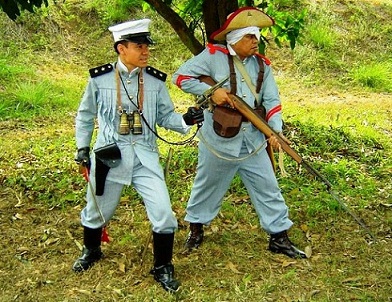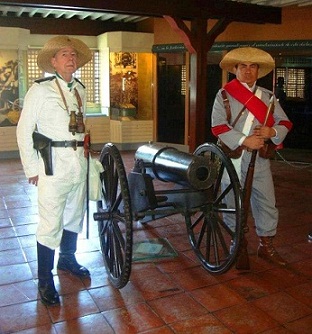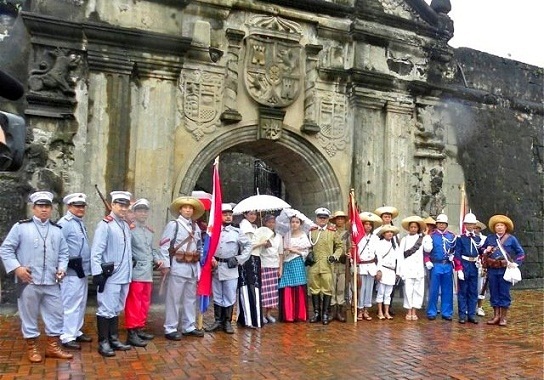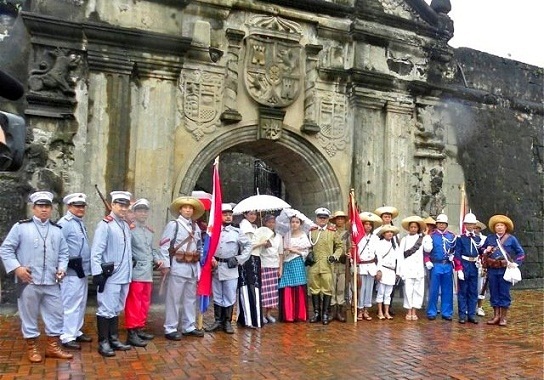By NORMAN SISON
 THE Philippine Revolution may be a memory, but not for a group of history re-enactors. For them, history is not only a record of events past but also lessons for the future.
THE Philippine Revolution may be a memory, but not for a group of history re-enactors. For them, history is not only a record of events past but also lessons for the future.
It began in 2003 with an epiphany. Like many Filipinos, electrical engineer Pedro Javier liked all things foreign. But later he realized that a large part of the country’s many problems came from Filipinos’ general lack of appreciation for their own history.
“God made me a Filipino. He didn’t make me an American,” he says. “If Filipinos won’t care for their own country, who will?”
Inspired by the large-scale re-enactments of battles in the American Revolution and US Civil War, Javier pondered: why not borrow the idea? So, the first step was to make replica uniforms worn by Filipino revolutionaries over a century ago.
The present Philippine Army traces its lineage to the 1897 Tejeros Convention, when the Philippine revolutionary government was formed, with General Emilio Aguinaldo as the new republic’s first president.
It was there where the Philippine Republican Army, formally called the Ejercito en la Republica de las Islas Filipinas, was born with General Artemio Ricarte as its first capitan-general. When General Antonio Luna replaced Ricarte in 1898, he commissioned his brother, the celebrated painter Juan Luna, to design the uniforms.
The uniforms looked similar to those worn by the Spanish Army because they used the same blue and white striped cotton fabric, known as rayadillo (“striped material”), which was perfect for the tropics.
 From afar, the uniforms appeared light blue. That prompted American soldiers fighting Spaniards in the Spanish-American War (1898) and Filipinos in the subsequent Philippine-American War (1899-1902) to sneer that their opponents were wearing pajamas.
From afar, the uniforms appeared light blue. That prompted American soldiers fighting Spaniards in the Spanish-American War (1898) and Filipinos in the subsequent Philippine-American War (1899-1902) to sneer that their opponents were wearing pajamas.
Very few rayadillo uniforms survive today. Many are in the hands of private collectors in the United States. Antonio Luna’s uniform is on display at the Lunas’ ancestral home in Badoc, Ilocos Norte province.
Javier spent hundreds of hours combing museums and libraries for historical photos, as well as the Internet for pictures of rayadillo uniforms that survived the march of time. Juan Luna had designed a uniform for each rank, making research more painstaking.
After that, the next challenge was finding a tailor who could make the fabric, a straw hat maker willing to weave the hats worn in the old days, a leather craftsman who could make the boots and ammunition belts and pouches, and a shop that could make detailed brass buttons and pins that were typical of military uniforms in the late 19th century.
Finally, in 2006, Javier marched out in a replica Antonio Luna rayadillo at a ceremony at the University of the Philippines marking the 143rd birthday of the Katipunan supremo Andres Bonifacio, the father of the Philippine Revolution.
Since then, Javier has slowly been attracting like-minded patriots — a businessman, call center agent, construction worker, doctor, lawyer, photographer, public school teacher, among others. One of their members is a Briton married to a Filipina.
Aside from staging reenactments of battles, Javier’s group, Buhay na Kasaysayan (“Living History”), occasionally stages exhibits, gives lectures on history and nationalism, and attends celebrations commemorating historical events.
Public school teacher Sumaquel Hosalla, who later joined the group, admits that he — even with his strong sense of patriotism running in his veins — initially felt embarrassed when he first wore his rayadillo.
“I felt like I was a mascot,” says Hosalla, who teaches at Batasan Hills National High School in Quezon City. But embarrassment immediately gave way to pride when people started having their photos taken with him.
“People discovered that our revolutionaries had proper uniforms,” Hosalla says. “Filipinos’ notion of the revolutionaries was that they were barefooted peasants armed with bolos. Our soldiers were in uniform, professional, orderly and dignified.”
Hosalla laments the general lack of historical sense among Filipinos. “History is critical in the shaping of a nation, which in turn forms the foundation of a country.”
Giving an example, he says the Philippines’ inability to keep out Chinese ships from intruding into the country’s territory and seizing Scarborough Shoal in the South China Sea demonstrates what can happen when Filipinos don’t care enough.
“When people are ignorant of their own history, they don’t develop love of country,” Hosalla explains. “Territory and sovereignty are important in building a country. If our territory is taken away from us just like that, it’s as if we Filipinos are being trampled on. It is our responsibility as citizens to defend our territory.”
For Javier, one value of keeping the revolutionary spirit alive is to remind Filipinos that they had a glorious beginning. “I want people to see and remember the Filipino heroes who risked their lives to provide the freedom that we currently enjoy.”
But he wants to go farther than that: to inspire Filipinos into believing that the Philippines can be great again — and that it’s all in their hands.
“I want also to instill in their minds subconsciously not only to admire our heroes, but to aspire to be a hero in their own special way,” he says. “We do not need to become extraordinary or have great intelligence to become heroes. We can be ordinary people doing extraordinary deeds.”

